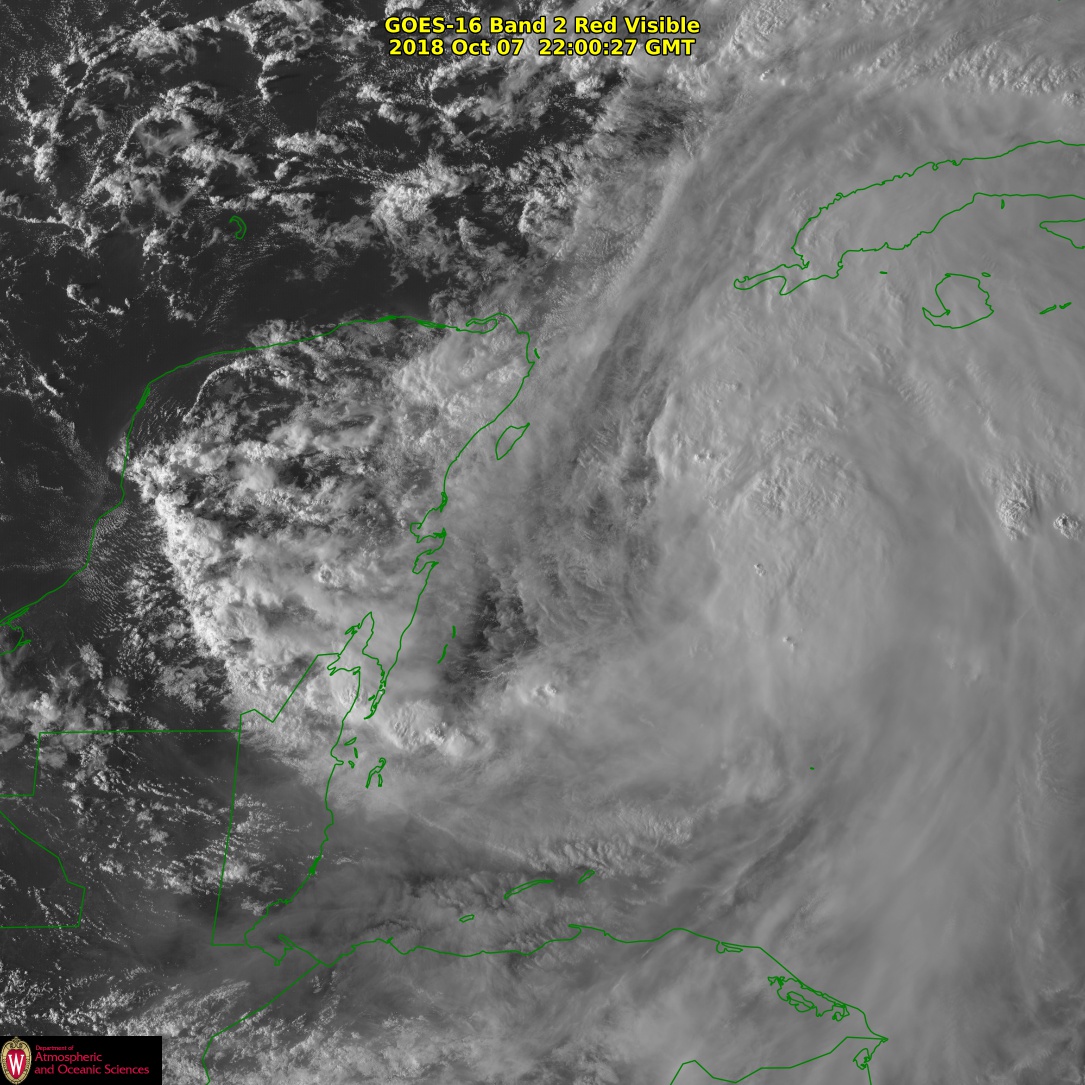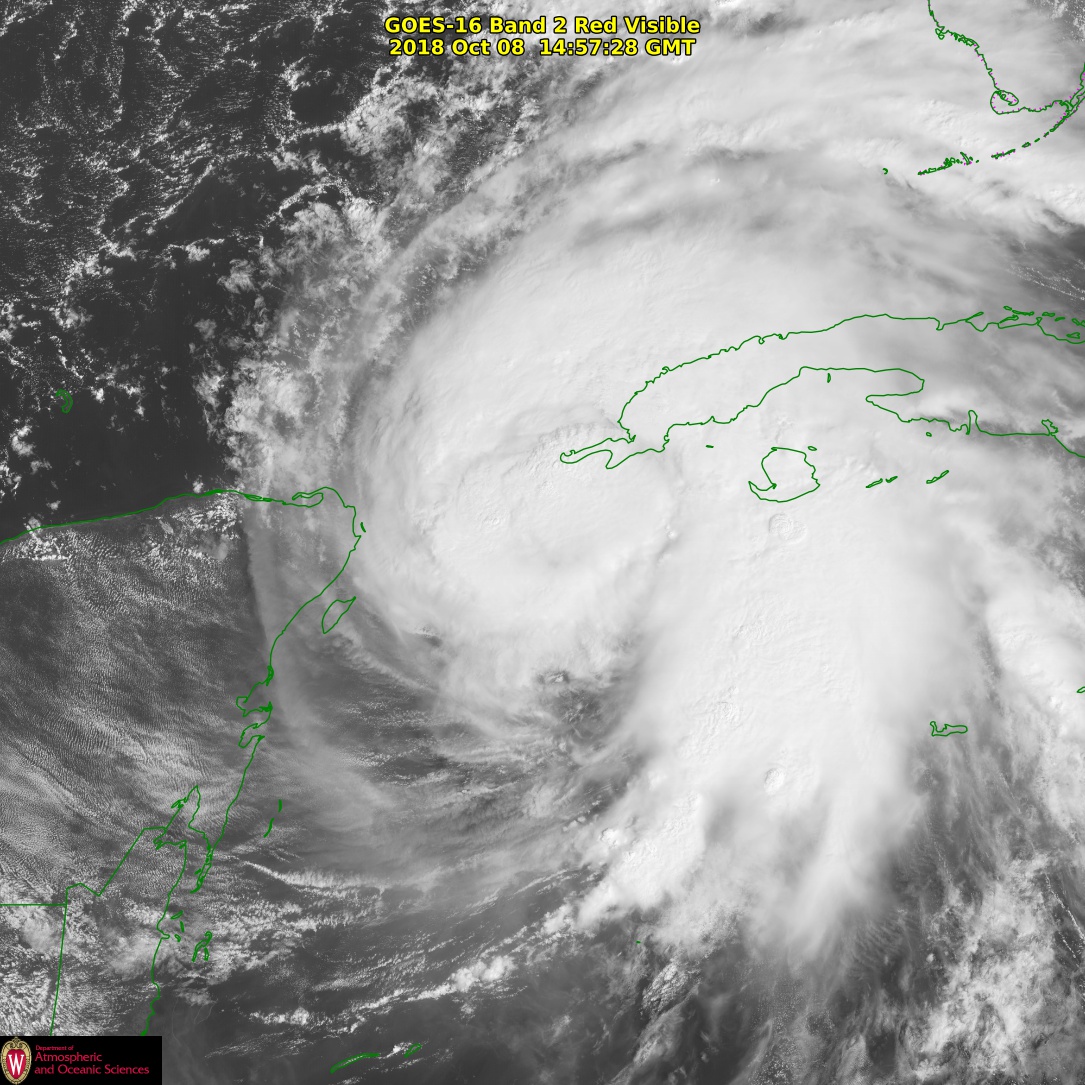Tropical Storm Michael
1-minute Mesoscale Domain Sector GOES-16 (GOES-East) “Clean” Infrared Window (10.3 µm) images (above) showed deep convection associated with Tropical Depression 14 east of Belize and the Yucatan Peninsula of Mexico early in the day on 07 October 2018. There was a large area of cloud-top infrared brightness temperatures in the -80ºC to -89ºC range (shades of purple), with isolated small pockets of -90ºC or colder (yellow enhancement).1-minute GOES-16 “Red” Visible (0.64 µm) images from the UW-AOS site (below) showed numerous convective overshooting tops.
At 1655 UTC the system was upgraded to Tropical Storm Michael — 1-minute GOES-16 Infrared images (below) showed that deep convection persisted in the eastern semicircle of Michael during the remainder of the day. A hint of the elongated low-level circulation could be seen just west of the deep convection on late-day GOES-16 Visible images (below).===== 08 October Update =====
![NOAA-20 VIIRS Day/Night Band (0.7 µm), Infrared Window (11.45 µm) and ATMS Microwave (88 GHz) images [click to enlarge]](https://cimss.ssec.wisc.edu/satellite-blog/wp-content/uploads/sites/5/2018/10/181008_0721utc_noaa20_DayNightBand_InfraredWindow_Microwave_TS_Michael_anim.gif)
NOAA-20 VIIRS Day/Night Band (0.7 µm), Infrared Window (11.45 µm) and ATMS Microwave (88 GHz) images [click to enlarge]
In a comparison of DMSP-18 SSMIS Microwave (86 GHz) and GOES-16 Infrared Window (10.3 µm) images at or shortly after 1115 UTC (below), the Microwave imagery showed a very large eye beneath the convective clusters.
Michael was upgraded to a Category 1 hurricane at 15 UTC; 1-minute GOES-16 “Red” Visible (0.64 µm) images (below) revealed abundant deep convection around the core of the storm during the 3 hours leading up to that time. Michael had been moving over very warm water since forming on 06 October; analyses of Ocean Heat Content and Sea Surface Temperature (below) showed that while the hurricane was forecast to briefly pass over a region of lower OHC in the far southeastern Gulf of Mexico, the remainder of its journey across the Gulf would be over water possessing modest amounts of OHC and warm SST values of 29-30ºC. Similarly, a relatively cloud-free Terra MODIS Sea Surface Temperature product from 0343 UTC on 06 October (below) showed SST values of 84-85ºF (darker red colors) along much of the forecast path of Hurricane Michael (issued at 2100 UTC on 08 October).



![DMSP-18 SSMIS Microwave (86 GHz) and GOES-16 Infrared Window (10.3 µm) images [click to enlarge]](https://cimss.ssec.wisc.edu/satellite-blog/wp-content/uploads/sites/5/2018/10/181008_1115utc_goes16_infrared_1126utc_dmsp18_microwave_Hurricane_Michael_anim.gif)

![Ocean Heat Content and Sea Surface Temperature analyses, with past and forecast tracks of Michael [click to enlarge]](https://cimss.ssec.wisc.edu/satellite-blog/wp-content/uploads/sites/5/2018/10/181007_ohc_sst_Michael_anim.gif)
![Terra MODIS Sea Surface Temperature product (0343 UTC on 06 October) with Hurricane Michael forecast positions issued at 2100 UTC on 08 October [click to enlarge]](https://cimss.ssec.wisc.edu/satellite-blog/wp-content/uploads/sites/5/2018/10/MODIS_SST_20181006_0343.png)